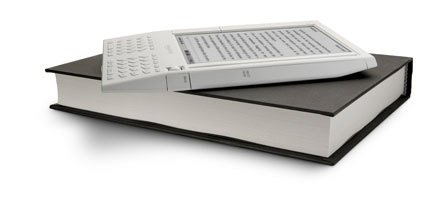Several months ago I wrote a brief review of the Sony Reader (PRS-500). The upshot was that I was extremely happy with mine, with just a couple of small caveats. Fast forward to today and I now have something else to compare it with, the Amazon Kindle.

There are plenty of comprehensive reviews of the Kindle floating around so I don’t think we need another one. Instead, I’ll focus on comparing it with the Sony Reader.
Screen
The Kindle seems to share the same screen as the Sony Reader. Holding the two side by side, I can’t find any difference in the quality of the output. The screen requires slightly more light to comfortably read than a paper book would since it isn’t quite as high-contrast as ink and paper. But that’s really a minor gripe.
Battery
As far as battery life is concerned, the Kindle can easily go for multiple books without recharging the battery, particularly if you turn off the wireless functionality. With wireless enabled, it seems to drop to around half power in a couple of days—I typically recharge at that point so that I never have to fear running out of juice in the middle of reading.
Wireless access
The wireless access to the Kindle store is fantastic. I like to take my Kindle with me anytime I’m going to be sitting and waiting for something for more than a few minutes. With my Sony Reader I had to be proactive about making sure I had additional books loaded and ready for after I finished what I was currently reading. I find that I have pretty distinct reading moods, so having the flexibility to add content on demand is a really big plus for me.
DRM
There were a lot of complaints flying around the internet after the Kindle was announced relating to its format support and DRM. All of the purchased content from Amazon is “protected” by DRM. This is really no different from any of the other major readers. I’m not bothered by it.
PDF support
The other main complaint was lack of PDF support, and I read a number of blogs that cited that as a reason why the Sony Reader was superior. The Kindle supports Mobipocket formatted content, and there are converters from PDF to Mobipocket available. The output looks pretty rough, but no worse than the built-in PDF support on the Reader. Overall, I think it’s a wash.
Interface
The last area I wanted to touch on is the interface. The most obvious difference is that the Kindle has a full keyboard, needed for its online functions, search, and the included mini-applications, like the dictionary and thesaurus.
The Kindle has very large next and previous page buttons that are really accessible—too much so sometimes. I often accidentally press next or previous page when I change my grip on the device. It’s not a big deal, but it’s definitely annoying when it happens.
On the other hand, the Kindle has a really ingenious scroll wheel and select cursor that is beside the screen. Since it’s not part of the eInk display itself, it doesn’t suffer from the slow refresh rate of the main screen. Oh, and it’s shiny.
Conclusion
Overall I’m very happy with my Kindle. It’s still not perfect, but it’s better than the Sony Reader in every category that matters to me. It’s a major evolutionary step, and the addition of painless wireless access definitely raises the bar for ebook readers.
Disclosure: Amazon’s Jeff Bezos is an investor in 37signals.

AkitaOnRails
on 14 Jan 08As a long time TWiT listener, I would recommend Steve Gibson’s Kindle review as well. Cheers.
Tim
on 14 Jan 08A direct link to the review AkitaOnRails mentions above.
Ben
on 14 Jan 08“The Kindle has very large next and previous page buttons that are really accessible—too much so sometimes. I often accidentally press next or previous page when I change my grip on the device. It’s not a big deal, but it’s definitely annoying when it happens.”
That sounds like a pretty terrible piece of design to get something so basic wrong.
John
on 14 Jan 08If your Kindle breaks, gets lost/stolen/destroyed, or you buy an upgraded Kindle, do you lose access to your previously-purchased content, or is there some way to transfer it from one Kindle to another?
MI
on 14 Jan 08John: Kindle purchased content is tied to your Amazon.com account. You can have multiple Kindles associated with your account and re-download any of your purchased content to any of the devices. The limit is 6 Kindles.
Seth
on 14 Jan 08I got a kindle the day they were first announced, and it compares favorably to an existing iliad reader that I had from work. The on-line store and delivery is the winning feature for me.
The amazon on-line conversion service does do PDF, without having to go through the mobipocket converters. I’ve converted a few PDF ebooks that way, without any issue.
John Clark
on 14 Jan 08Does either one show pictures.. For example if it’s a tech book that is downloaded do the pictures in the original book show on either one??
MI
on 14 Jan 08John: Both the Sony Reader and Kindle handle images fine, though they do have to work with a black and white display.
Charles Wilkes
on 14 Jan 08Good review of the Kindle and good comparision with the Sony Reader. I agree with everything I read here.
But I solved the too-large Next Page switch on the right by cutting off the two restrainers in the provided case and using Industrial Strength Velcro to attach my Kindle as far to the left as possible while still being able to close the case. What that does besides providing absolutely security preventing the Kindle from falling out of the case, is to leave the case protruding to the right of the Kindle, makng it easy to pick up the Kindle without accidentally pressing the switch on the right edge.
I then fold the left panel of the case clear around the back, holding it in place with the elastic band. This makes a great holder for the Kindle while reading—especially when reading using just one hand like when reading in bed. I never could read a paper book in bed before.
Charles Wilkes, San Jose, Calif.
A Guy from South America
on 14 Jan 08Forgot to say that the Kindle looks horrible and it looks like it uses cheap plastic on the outside. The keyboard needs to dissappear! Where are you Apple? Apple can easily kick Kindle’s butt big time. From your review I have the impression that you are kissing Bezo’s butt and since you couldn’t say Kindle is ugly, you had to compare it with another product to avoid having a bad review. Why find a worse product to make this one ‘look’ better? Both are bad products.
vb
on 15 Jan 08You guys promised an in depth review after use and consideration! Since I read the first mini review I’ve been waiting for a no-hype, non-gut-reaction SVN style review. I know there are other reviews out there, but I know you guys waited and thought about it before spewing. Could you either supplement the review or link to the reviews that best express your feelings on the subject?
MI
on 15 Jan 08vn: There’s a lot more I could have written, but I didn’t want to wind up writing a 3000 word novel on the subject. I’m happy to answer any specific questions you have though.
Duke
on 15 Jan 08How about textonphone – www.textonphone.com on iPhone?
Thibaut
on 15 Jan 08Thank you for this review Mark. I wondered if you found the Kindle was more appropriate for reading a certain kind of content. It’s rather a book vs. ebook question than a Kindle vs. Sony Reader question, but it’s an aspect of reading and accessibility that is important. To me, an ebook would be more suited for news, tutorials, technical material – for any information that has a limited time-span value, where traditional books seems better for a nice novel, poetry,... Also, was the limited choice in typography something you would like to be improved in the future versions of the Kindle ?
dusoft
on 15 Jan 08I bought Bookeen Cybook for reading e-books and it’s been wonderful so far. I think the shop is out of Bookeen reader until late January.
MI
on 15 Jan 08Thibaut: Actually, I find that ebook readers are fantastic for serial content like novels and less so for material where you might want to navigate beyond simple next/previous page. This was particularly true for the Sony Reader, and is somewhat lessened with the Kindle since it has a considerably better navigation scheme with the scroll wheel and the keyboard for doing searching, but it could be better still.
avagee
on 16 Jan 08MI I’m with you there, but for novels and straight prose I’d go even further – eReaders are overkill; too large, too complex, too expensive.
For a while now I’ve been reading a lot of novels on my cell phone, it’s almost perfect for this. I carry and charge it anyway, the screen is large enough for me to forget the device and be ‘in’ the text, and I can get free public domain books from http://www.booksinmyphone.com
This discussion is closed.